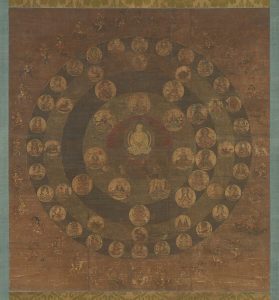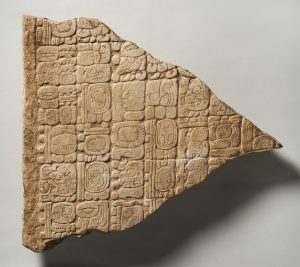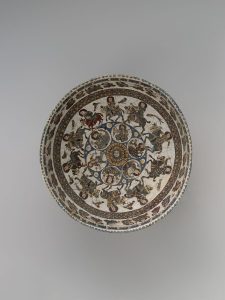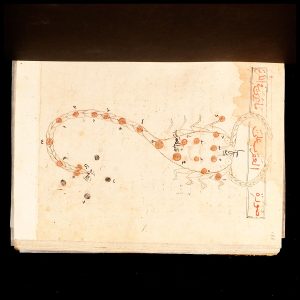11 Chapter 11: The art of ancient astrology
Maria Americo
Chapter 11: The art of ancient astrology
Within the world of ancient science, one of the most popular and most influential of the ancient studies of nature was that of astrology. Astrology is, in simplest terms, the belief and practice of using the appearances and configuration of the stars, the planets, the sun and the moon, and other celestial objects in order to determine messages for human life, relationships, and destiny. Every single ancient culture on earth has had, at some point during its history, a tradition of astrology; this was a global practice. And astrology continues to be alive and well in many places and in many ways until today. Let’s explore some of the rich tradition of astrological art together.
Bowl with astrological imagery
Iran
late 12th-early 13th century CE
-Image by the Metropolitan Museum of Art, used under a Creative Commons Zero (CC0) license, Public Domain
-Learn more about this art and find the image source here.
This glazed ceramic bowl from Late Antique Iran depicts, in the center, the sun; in the next concentric circle, 5 of the planets and the moon surrounding the sun; and in the third, outermost concentric circle, images of the zodiac signs and other constellations.
The imagery on this bowl is what we would call astrological, relating to the belief that the planets and stars have an effect on human life. But modern-day viewers of art with celestial themes sometimes forget that the sun, moon, planets, zodiac constellations, and other stars also have an astronomical, or strictly scientific, meaning as well. The arrangement of the celestial bodies on this bowl gives us visual evidence for the ancient understanding of how the universe and solar system fit together. In ancient Islamic astronomy, as well as in many other ancient traditions of astronomy, the celestial bodies like the moon, planets, and stars were thought to move in circular, concentric orbits they called spheres.
Questions for reflection
- Take a close look at the celestial bodies on this bowl. How are they depicted? Do they look like “real” planets and stars? What do they look like instead?
- What was a bowl like this used for? Was it a luxury object? Was it a scientific object?
- Do you know your zodiac sign? Look it up. Do you feel that the traditional characteristics associated with your sign accurately describe you?
Sources and further reading for this art
Islamic Art and Geometric Design: Activities for Learning – The Metropolitan Museum of Art
The Art of the Seljuqs of Iran (ca. 1040–1157) – The Metropolitan Museum of Art
Folio from Arabic text “Book of the Images of the Fixed Stars”
Iran
late 15th century
-Image by the Metropolitan Museum of Art, used under a Creative Commons Zero (CC0) license, Public Domain
-Learn more about this art and find the image source here.
As we explored in our chapter featuring premodern Islamic art, there was a historical phenomenon in the Middle East during Late Antiquity, which we call the Islamic translation movement. In the translation movement, older scientific texts from Greek, Latin, Persian, and other languages were translated into Arabic. This text, which is all about the constellations and configurations of the stars, was written in Arabic, and inspired by ancient Greek astronomy.
This diagram shows the stars that make up the zodiacal constellation Scorpio. Again, this image reminds us that, while Scorpio does indeed have an astrological and horoscopic meaning, it is also a real constellation, meaning a group of stars in the sky. There are many ways that our ancient ancestors studied and observed the stars, from spiritual to scientific.
Questions for reflection
- How are the stars of the constellation Scorpio marked on this diagram?
- What is a constellation? How was it decided what “shapes” or “images” the constellations make?
- How do the text and images interact in this manuscript folio?
Sources and further reading for this art
Science and the Art of the Islamic World | The Metropolitan Museum of Art
Art of the Islamic World: A Resource for Educators – The Metropolitan Museum of Art
3.

India
14th century CE
-Image by the Metropolitan Museum of Art, used under a Creative Commons Zero (CC0) license, Public Domain
-Learn more about this art and find the image source here.
In this illuminated manuscript folio from medieval India, the painted scene on the right depicts a king meeting with an astrologer. In the part of the story that is shown here, the king has summoned an astrologer because his wife, the queen, has had a dream that she will someday have a son. The astrologer interprets this dream to mean that the king and queen’s future son will someday become an important religious figure.
This scene teaches us about some of the usages and practices of astrology in the premodern world. Astrology was not only used for daily horoscopes and determining love compatibility; it was also seen as a way to help interpret dreams, understand destiny and fate, predict the future, and determine our place as humans in the universe.
Questions for reflection
- Describe the clothing, expressions, and body language of the two people depicted in this illuminated manuscript scene.
- Can you tell which figure is the king and which figure is the astrologer? How can you tell?
- What does this image tell us about how astrologers were treated in at least some times and places in the medieval world?
- What is the color scheme of this image? What do the colors evoke or symbolize?
Sources and further reading for this art
4. 
Star mandala
Japan
13th-14th century CE
-Image by the Metropolitan Museum of Art, used under a Creative Commons Zero (CC0) license, Public Domain
-Learn more about this art and find the image source here.
This is a mandala, an art style we have already explored together, painted with colored and gold ink on a silk hanging scroll. Like all mandalas of the Buddhist tradition, this mandala would have been used to guide and focus the mind during meditation.
This particular mandala is called a “star mandala,” and, reading it from the inside of the circle out, in the center we see the Buddha, seated in a meditation posture, and all around him are arranged celestial objects of astrological meaning: the constellation that we call the Big Dipper; the planets and the sun and moon; the twelve zodiac signs; and other animals and stars important in Japanese Buddhist cosmology. It was thought that meditating on this mandala would help the spiritual seeker understand, foresee, and prevent misfortunes that might occur, written in the stars.
Questions for reflection
- How are the different elements of this mandala arranged? How does their arrangement echo the arrangement of the real sun, moon, planets, and stars?
- What is the color scheme and mood of this mandala?
- What do you believe about destiny, fate, and the future? Is our fate written—in the stars, or somewhere else? Do we have the ability to change the future or our fate?
Sources and further reading for this art
Credo Reference – mikkyō (Japanese Esoteric Buddhism)
Credo Reference – Japanese religions
5. 
Mayan calendar funerary stela
Mexico
4th-9th century CE
-Image by the Metropolitan Museum of Art, used under a Creative Commons Zero (CC0) license, Public Domain
-Learn more about this art and find the image source here.
This is an ancient Mayan funerary stela. A stela is an inscription used in a tomb or other burial structure, or in some other commemorative way. And this stela is one of the most famous ancient astrological objects.
The text on this fragmentary portion of the stela was once believed to contain a prophecy, a terrible event that was predicted to happen on a future day according to the ancient Mayan calendar, and which modern-day readers of the text calculated to be in December 2012. This misinterpretation of the text—which, like all historical texts, needs to be read in its own context and not projected onto modern-day interpretations—led to a sensationalist belief that the end of the world would occur in December 2012. The predicted apocalypse did not happen. But the ancient Mayan calendar, based on astrology and the movements of the planets and stars, gained worldwide fame.
Questions for reflection
- Describe this funerary stela. What do you see here?
- Do you remember the theories, based on a misreading of this Mayan funerary text, that the world might end in December 2012?
- Why are ancient texts sometimes misinterpreted or misunderstood?
- If you could see into the future, would you want to know what was going to happen in your life?
Sources and further reading for this art
Credo Reference – Harmonic Convergence (Mayan calendar prophecy)
Credo Reference – The Mayan and Aztec Calendars
Media Attributions
- Persian astrological bowl
- Arabic Scorpio
- Indian astrology manuscript folio
- Japanese star mandala
- Mayan calendar funeral stela


